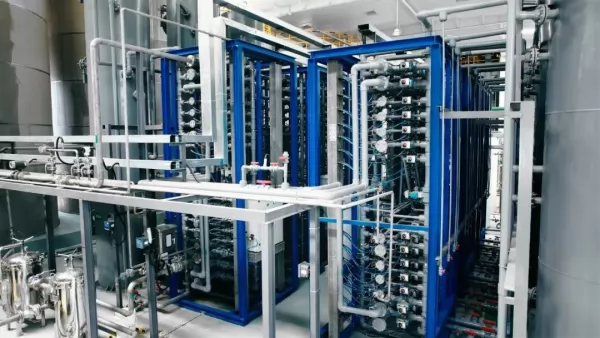
L-Homoserine desalination and refining process case
L-homoserine is a aminoacid that is widely used as an important aminoacid feedstock in the fields of food, healthcare products, cosmetics, biomedicines, and other related industries.
Desalination and removing impurities of L-homoserine:
_1698302462_WNo_600d329.webp)
During the extraction and preparation of L-homoserine, impurities can often interfere with the process, making it difficult to achieve the desired level of purity. Therefore, desalting and impurity removal processes are necessary to improve the purity of L-homoserine during its extraction and preparation. Currently, the mainstream methods for desalting and impurity removal in L-homoserine production include:
1) Centrifugation:
Centrifugation is a widely used method for removing impurities during L-homoserine production. This process involves concentrating the fermentation broth by centrifugation and separating the organic phase to achieve separation and purification. Centrifugation is a highly efficient production process that can effectively remove proteins, carbohydrates, and other impurities present in the fermentation broth.
2) Acid precipitation method:
Another method commonly used for impurity removal during L-homoserine production is the acid precipitation method. This technique involves precipitating and removing proteins from the fermentation broth through the addition of an acidic solution. The acid precipitation method is particularly effective for fermentation broths with high protein content, as the proteins can be easily removed by centrifugation after precipitation. Further purification of the L-homoserine can then be achieved through additional techniques such as centrifugation or chromatography.
3) Resin Adsorption Method:
The resin adsorption method is another technique commonly used in the production of high-quality L-homoserine. This method involves using materials such as ion exchange resins to selectively adsorb the L-homoserine and remove impurities. The resin adsorption method offers several advantages, including high efficiency, rapidity, and good selectivity.
4) Chromatographic separation technology:
Chromatographic separation technology is used to remove inorganic salts, pigments and other impurities from the L-homoserine feed solution. The separated extract is decontaminated by a refining resin, and the purified L-homoserine is subjected to the late stage of process in order to enhance the whole line yield and quality of the L-homoserine product.
Experimental cases of purification of L-homoserine by chromatography:
1)Purpose of the experiment:
Chromatography technology has been successfully applied in the production of various amino acid-related products. In this case, a customer has sent a 3000L L-homoserine membrane clear liquid to our company to conduct a chromatography pilot debugging experiment. The primary objective of this experiment is to evaluate the separation performance of Sunresin's resin and to study the process performance of SSMB chromatography in the separation and purification of L-homoserine.
2)Experimental Feedstock:
For this experiment, the L-homoserine fermentation broth was filtered to achieve 18% solid holdup, a pH of 6.8, and a conductivity of 10320 μs/cm. The resulting filtrate was then used as the feedstock for the chromatography process. The feedstock was analyzed as follows:
| L-homoserine Feedstock | |
|---|---|
| Analysis Item | L-L-homoserine |
| Appearance | Red brown |
| Solid Holdup(%) | 18 |
| Density(g/ml) | 1.06 |
| pH | 6.55 |
| Conductivity | 10320 |
| L-homoserine Acidity(%) | 10-10.5 |
3)Chromatographic separation experimental effect:
Through the continuous optimization and adjustment of chromatographic production debugging, the specific performance of chromatography is as follows:
| SSMB chromatographic separation performance data | ||
|---|---|---|
| Analysis Item | Extracting Solution | Residual liquid |
| Appearance | clear, yellow | clear, reddish-brown |
| L-homoserine yield coefficient(%) | 94-96 | - |
| L-homoserine purity(%) | 90-92 | - |
4)Experimental summary:
Based on the chromatographic pilot experiment with loading Sunresin’s resin, the following conclusions can be drawn:
-Under the current feed conditions, maintaining very low water consumption, the pilot test can obtain a good separation of L-homoserine from solid analytical yield of more than 95%, purity of more than 90%, and removal of other impurities;
-With the second optimization of parameters, the pigment of the extract was reduced from red to light yellow, and the decolorization effect was significantly improved.
Sunresin SSMB choromatagraphic separation equipment:

For the high salt problem prevailing in the current fermentation broth, Sunresin has developed SSMB continuous chromatography salt separation process and continuous ion exchange process by combining the characteristics of the broth.
Chromatographic separation principle:
The purpose of chromatography is to separate the feed material into two parts.
-the product phase, which contains the L-homoserine component with high recovery and high content;
-the impurity phase, which contains a very small amount of the target component and a large proportion of salts, pigments and other impurities;
The process is a continuous chromatography system called sequential analog moving bed. It consists of a number of successive cycles of resin-filled separation chambers, which are called "sequential simulated moving bed" because the movement of the resin bed is simulated by the periodic alternation of the inlet and outlet of each unit.
The chromatographic packing is a homogeneous resin with different binding/affinity for each component.
Advantages of Chromatographic Separation Units:
The advantages of SSMB are obvious:.
-Continuous and smooth feed/discharge, ensuring system stability and reliability;
-High purity components can be obtained;
-Lower water consumption and resin usage per unit of product separated in a continuous system compared to a batch process because the system has no intermediate components to remove, mix and re-feed;
-Compared to conventional ion exchange, it consumes virtually no chemicals and is more environmentally friendly.
In order to achieve the best performance of the system, precise control of the flow rate through the different areas of the chromatographic separation column will be accomplished by the automatic control of the system to automatically and accurately switch between different process steps.















